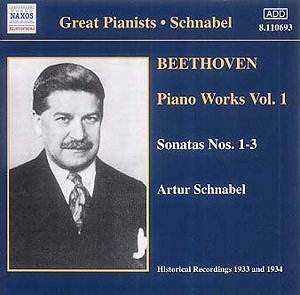My last encounter with these performances was in a
transfer by Phonographie, a division of the Italian company Nuova Era
(PH 5008), issued in 1994. This used the CEDAR process, and the differences
are so striking that I’d better start with the sound itself.
Turning to the Phonographie version after the Naxos,
you are immediately struck by the practically total absence of 78 surface
noise. I tend to be rather suspicious of this, remembering the days
when LP transfers of 78s often arrived with the background hiss filtered
off, and half the performance with it. But the CEDAR is a computerised
process which is supposed to be able to take off the hiss without
sacrificing the higher frequencies; it somehow identifies what has to
be taken off and, or at least this is the aim, takes off only
that. Still suspicious of substituting the computer for an acute pair
of human ears, especially when they belong to someone like Mark Obert-Thorn,
I nevertheless did start by preferring the Phonographie. All the nuances
were preserved, the tone had a plausible presence and it sounded, not
like a modern recording perhaps, but about twenty years more recent
than it is.
And yet … Something didn’t convince, for it was a close,
airless sound, as though recorded in a tiny studio hemmed in with sound-absorbers.
The Naxos transfer is more distanced and seems to retain some of the
ambience of the hall it was made in – as much, I dare say, as the original
78s could ever yield. What clinched it for me was the run of demi-semi-quavers
at bb. 25-6 of the slow movement of the First Sonata. The CEDAR process
has not only filtered out the ambience, it has filtered out the magic.
So in the end there is no substitute for the human ear. Transfer engineers
have artistic decisions to make and Obert-Thorn (whose transfer of the
Schnabel "Emperor" did not impress me) has here achieved a
sound that surely brings us as close to Schnabel as we are likely to
get. Yes, it does still sound like an old recording, but it has a fair
range, is remarkably full-bodied at times, and allows the piano to sing.
So now down to the performances, and let me start by
playing the devil’s advocate. As the Allegro of no. 1 starts, the acciaccaturas
anticipate the beat so that the rhythm starts falling all over itself,
the dotted rhythms from b. 10 are just not dotted (of the versions I
have to hand only Melvyn Tan, on the fortepiano and at a slower tempo,
gets this rhythm as badly wrong as Schnabel), the forte eruption is
an excuse to freshen up the tempo (and whoops, there’s a wrong note!),
he tears ahead at the following quaver passage and in the "con
espressione" leading up to the double bar there are some more anticipated
grace notes that virtually re-compose the music, and his haste to get
onto the big fortissimo chord causes him to double-dot the preceding
dotted rhythm.
Quite a catalogue, and that’s just in the exposition
of one movement. It takes me back to the days when I was preparing op.
14/2 for my Grade 8 and got hold of the Schnabel recording. My teacher
heard it and said sniffily, "I hope you’re not going to take that
for a model". She was right, of course, up to a point. Any student
who did all these things, without the vital spark, should be
sent home to do his practice properly. And yet, if that student succeeded,
as Schnabel does, in bringing before us the young, impetuous Beethoven
in person, as none of the "correct" performances quite manage
to do, then I hope that teachers and examiners would bow down before
him and recognise that it is the spirit that counts.
Not that we always have to choose between the spirit
and the letter so signally as in this movement. The following Adagio
should silence the most virulent Beckmesser. And yet it raises an interesting
point. Look at the following timings:
Schnabel: 6’ 02"
Brendel (1984): 4’ 40"
Nikolayeva: 5’ 47"
Perahia: 4’ 42"
Tan (fortepiano): 4’ 11"
The swifter performers will point to the fact that
there are three beats in the bar not six, yet what struck me on listening
to Schnabel is how mobile it is, how utterly free from the constraints
of the beats and the bars. Good as the Brendel and Perahia are, you
hear the beats and they seem heavier even if they are faster. And the
only one that is within calling distance of Schnabel’s timing, Nikolayeva,
sounds woefully slow. Schnabel’s simple songfulness, his sense of repose,
finds the sublime without a trace of sententiousness even in these early
movements (those of the other two sonatas are equally fine).
And so one could go on. How he makes the opening of
no. 2 speak, how truly graceful is the Rondo which concludes that sonata,
and how he finds the humour in the closing movement of no. 3. And incidentally,
the semiquavers on the first page of this, as well as the intrepidly
attacked trio of the preceding Scherzo, show that when he was settled
in, his digital dexterity was remarkably fluent – a good Leschetizky
pupil after all (Leschetizky was the teacher who told him he would never
become a pianist; he was a musician).
Here, then, is the first instalment of what remains
the locus classicus of Beethoven playing. It is as essential
to us today as it was when it was new.
Christopher Howell


